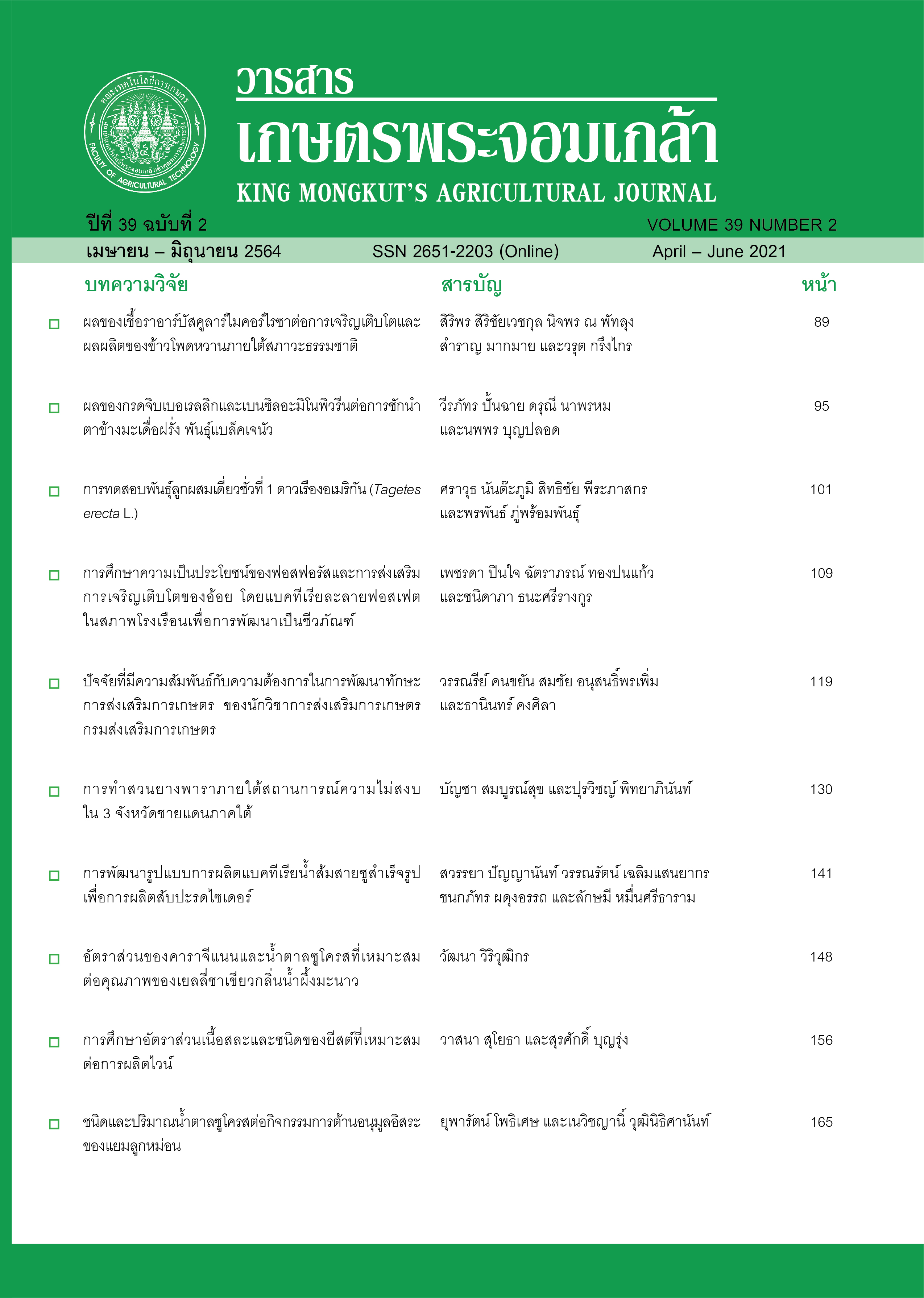การศึกษาความเป็นประโยชน์ของฟอสฟอรัสและการส่งเสริมการเจริญเติบโตของอ้อย โดยแบคทีเรียละลายฟอสเฟตในสภาพโรงเรือนเพื่อการพัฒนาเป็นชีวภัณฑ์
Main Article Content
บทคัดย่อ
แบคทีเรียส่งเสริมการเจริญเติบโตของพืช (PGPR) เป็นแบคทีเรียที่มีประโยชน์ที่อาศัยอยู่บริเวณรากพืช ซึ่งสามารถส่งเสริมการเจริญเติบโตของพืชด้วยกลไกต่าง ๆ เช่น การตรึงไนโตรเจน การผลิตฮอร์โมนพืช การละลายฟอสเฟต และการผลิตซิเดอร์โรฟอร์ เป็นต้น ซึ่งงานวิจัยนี้สนใจศึกษาแบคทีเรียส่งเสริมการเจริญเติบโตของพืชที่คัดแยกจากดินบริเวณรากอ้อยในจังหวัดสระแก้ว เพื่อนำมาทดสอบการละลายฟอสเฟตในระดับห้องปฏิบัติการและสภาพโรงเรือนก่อนนำไปใช้ประโยชน์ในภาคสนาม งานวิจัยนี้มีวัตถุประสงค์เพื่อตรวจสอบความสามารถในการละลายฟอสเฟตของแบคทีเรียที่ระดับความเข้มข้นของเซลล์และพีเอชที่ต่างกันในอาหารเลี้ยงเชื้อ และตรวจสอบผลของแบคทีเรียละลายฟอสเฟตต่อการเจริญเติบโตของอ้อย ผลการศึกษาในห้องปฏิบัติการพบว่าระดับความเข้มข้นของเซลล์เริ่มต้นที่ 108 CFU/ml ของแบคทีเรียเป็นระดับที่เหมาะสมต่อการละลายฟอสเฟต แบคทีเรียสามารถละลายฟอสเฟตได้เท่ากับ 212.5-787.5 µg/ml ที่ระดับ pH ในพิสัย 5-9 ขณะที่ไม่สามารถเจริญและละลายฟอสเฟตได้ที่สภาวะกรดจัดรุนแรง (pH 4.0) นอกจากนี้พบว่าแบคทีเรียตัวแทน 2 ไอโซเลต ได้แก่ Kosakonia radicincitans (PSB1) และ Bacillus subtilis (PSB2) ส่งผลเชิงบวกต่อการเจริญเติบโตของอ้อย โดยการใส่เชื้อเดี่ยว PSB1 ร่วมกับหินฟอสเฟตส่งผลให้อ้อยมีการเจริญเติบโตในด้านของความสูง น้ำหนักสดลำ จำนวนลำ ความยาวปล้อง ความยาวลำ และเส้นผ่านศูนย์กลางลำเพิ่มขึ้นแตกต่างทางสถิติกับชุดควบคุม รวมทั้งความเป็นประโยชน์ของฟอสฟอรัสในดินเพิ่มขึ้น โดยการใส่เชื้อร่วมกันกับการเติมหินฟอสเฟตในภาพรวมให้ผลดีกับอ้อยมากที่สุด ดังนั้นแบคทีเรียตัวแทนทั้ง 2 ไอโซเลตนี้จึงน่าจะมีความเหมาะสมที่จะนำไปทดสอบในสภาพไร่เพื่อตรวจสอบผลต่อการส่งเสริมการเจริญเติบโตของอ้อยในสภาพไร่ และพัฒนาเป็นปุ๋ยชีวภาพต่อไปในอนาคต
Article Details
วารสารเกษตรพระจอมเกล้า
เอกสารอ้างอิง
คณาจารย์ภาควิชาปฐพีวิทยา. 2548. ปฐพีวิทยาเบื้องต้น. พิมพ์ครั้งที่ 9. กรุงเทพฯ: ภาควิชาปฐพีวิทยา คณะเกษตร มหาวิทยาลัยเกษตรศาสตร์.
ปัทมา วิตยากร. 2533. ดิน: แหล่งธาตุอาหารของพืช. ขอนแก่น: ภาควิชาปฐพีศาสตร์ คณะเกษตรศาสตร์ มหาวิทยาลัยขอนแก่น.
เพชรดา ปินใจ, เสาวนุช ถาวรพฤกษ์ และณัฐพล จิตมาตย์. 2557. การศึกษาแนวทางการใช้แบคทีเรียส่งเสริมการเจริญเติบโตของพืชต่อการเพิ่มผลผลิตอ้อยเพื่อการพัฒนาเป็นชีวภัณฑ์. ใน รายงานวิจัยฉบับสมบูรณ์ (โครงการย่อยที่ 2) ภายใต้แผนงานวิจัยการพัฒนาดัชนีคุณภาพและผลิตภาพของดินเพื่อการผลิตอ้อยในภาคตะวันออกของประเทศไทย. สำนักงานกองทุนสนับสนุนการวิจัย.
Akhtar, N. I., Arshad, M. A., Shakir, M. A., Qureshi, J., Sehrish, J., and Ali, L. 2013. Co-inoculation with Rhizobium and Bacillus sp.
to improve the phosphorus availability and yield of wheat (Triticum aestivum L.). Journal of Animal and Plant Sciences
: 190-197.
Bajpai, P. D., and Sundara, R. W. V. B. 1971. Phosphate solubilizing bacteria. Solubilization of phosphate in liquid culture by selected bacteria as affected by different pH values. Journal of Soil Science and Plant Nutrition 17: 41-43.
Boden, G., Master, R. W., Rezvani, I., Palmer, J. P., Lobe, T. E., and Owen, O. E. 1980. Glucagon deficiency and hyperaminoacidemia after total pancreatectomy. The Journal of Clinical Investigation 65: 706-716.
Bray, R. H., and Kurtz, L. T. 1945. Determination of total, organic and available forms of phosphorus in soils. Soil Science 59: 39-45.
Bremner, J. M., and Mulvaney, C. S. 1982. Nitrogen-Total. In Methods of Soil Analysis, Part 2. 2nd ed., Agronomy Monograph No. 9, A. L. Page, R. H. Miller, and D. R. Keeney, eds. pp. 295-324. Madison, WI: American Society of Agronomy.
Chapman, H. 1965. Cation exchange capacity. In Methods of Soil Analysis, C. A. Black, ed. pp. 891-901. Madison, WI: American Society of Agronomy.
Chen, Y. P., Rekha, P. D., Arun, A. B., Shen, F. T., Lai, W. A., and Young, C. C. 2006. Phosphate solubilizing bacteria from
subtropical soil and their tricalcium phosphate solubilizing abilities. Applied Soil Ecology 34: 33-41.
Goldstein, A. H. 1986. Bacterial solubilization of mineral phosphates: historical perspective and future prospects.
American Journal of Alternative Agriculture 1: 51-57.
Lim, S. 1991. Standard methods for the examination of water and wastewater. Washington, D.C.: American Public Health Association.
Metha, S., and Nautiyal, C. S. 2001. An efficient method for qualitative screening of phosphate solubilizing bacteria.
Current Microbiology 43: 51-56.
National Soil Survey Center. 1996. Soil survey laboratory methods manual, Soil survey investigations report No.42, version 3.0. Lincoln, NE: Natural Resources Conservation Service, United States Department of Agriculture. U.S. Government Printing Office.
Nelson, D. W., and Sommers, L. E. 1996. Total carbon, organic carbon, and organic matter. In Methods of Soil Analysis. Part 3. Chemical methods. Soil Science of America and American Society of Agronomy, C. A. Black, ed. pp. 961-1010.
Madison, WI: Soil Science Society of America.
Panwar, M., Tewari, R., and Nayyar, H. 2014. Microbial consortium of plant growth-promoting rhizobacteria improves the performance of plants growing in stressed soils: an overview. In Phosphate Solubilizing Microorganisms, M. S. Khan, A. Zaidi,
J. Musarrat, eds. pp. 257-285. Switzerland: Springer International Publishing.
Pratt, P. F. 1965. Potassium. In Methods of Soil Analysis. Part 2. Chemical and Microbiological Properties, C. A. Black, ed.
pp. 1023-1031. Madison, WI : American Society of Agronomy.
Qureshi, A. S., Dahot, U., and Panhwar, S. I. 2010. Biosynthesis of alkaline phosphatase by Escherichia coli. Efr 13 in submerged fermentation. World Applied Sciences Journal 8: 50-56.
Qureshi, M. A., Lqbal, A., Akhtar, N., Shakir, M. A., and Khan, A. 2012. Co-inoculation of phosphate solubilizing bacteria and rhizobia in the presence of L-tryptophan for the promotion of mash bean (Vigna mungo L.). The Journal Soil & Environment
: 47-54.
Reena, D. T., Deepthi, H., Pravitha, M. S., and Lecturer, D. 2013. Isolation of phosphate solubilizing bacteria and fungi from rhizospheres soil from banana plants and its effect on the growth of Amaranthus cruentus L. IOSR Journal of Pharmacy and Biological Sciences 5: 6-11.
Stephen, J., and Jisha, M. S. 2011. Gluconic acid production as the principal mechanism of mineral phosphate solubilization by Burkholderia sp. (MTCC 8369). Journal of Tropical Agriculture 49: 99-103.
Sundara, B., Natarajan, V., and Hari, K. 2002. Influence of phosphorus solubilizing bacteria on the changes in soil available phosphorus and sugarcane and sugar yield. Field Crop Research 77: 43-49.
Tripura, C., Sashidhar, B., and Podile, A. R. 2007. Ethyl methanesulfonate mutagenesis-enhanced mineral phosphate solubilization by groundnut-associated Serratia marcescens GPS-5. Current Microbiology 54: 79-84.
Thomas, G. W. 1982. Exchangeable cations. In Methods of Soil Analysis, Part 2. 2nd ed., Agronomy Monograph No. 9, A. L. Page,
R. H. Miller, and D. R. Keeney, eds. pp. 159-165. Madison, WI.: American Society of Agronomy.
Walpola, B. C., and Yoon, M. H. 2013. Phosphate solubilizing bacteria: Assessment of their effect on growth promotion and phosphorous uptake of mung bean (Vigna radiata [L.] R. Wilczek). Chilean Journal of Agricultural Research 73: 275-281.
Yadav, S., Kaushik, R., Saxena, A. K., and Arora, D. K. 2011. Diversity and phylogeny of plant growth promoting bacilli from moderately acidic soil. Journal of Basic Microbiology 51: 98-106.


